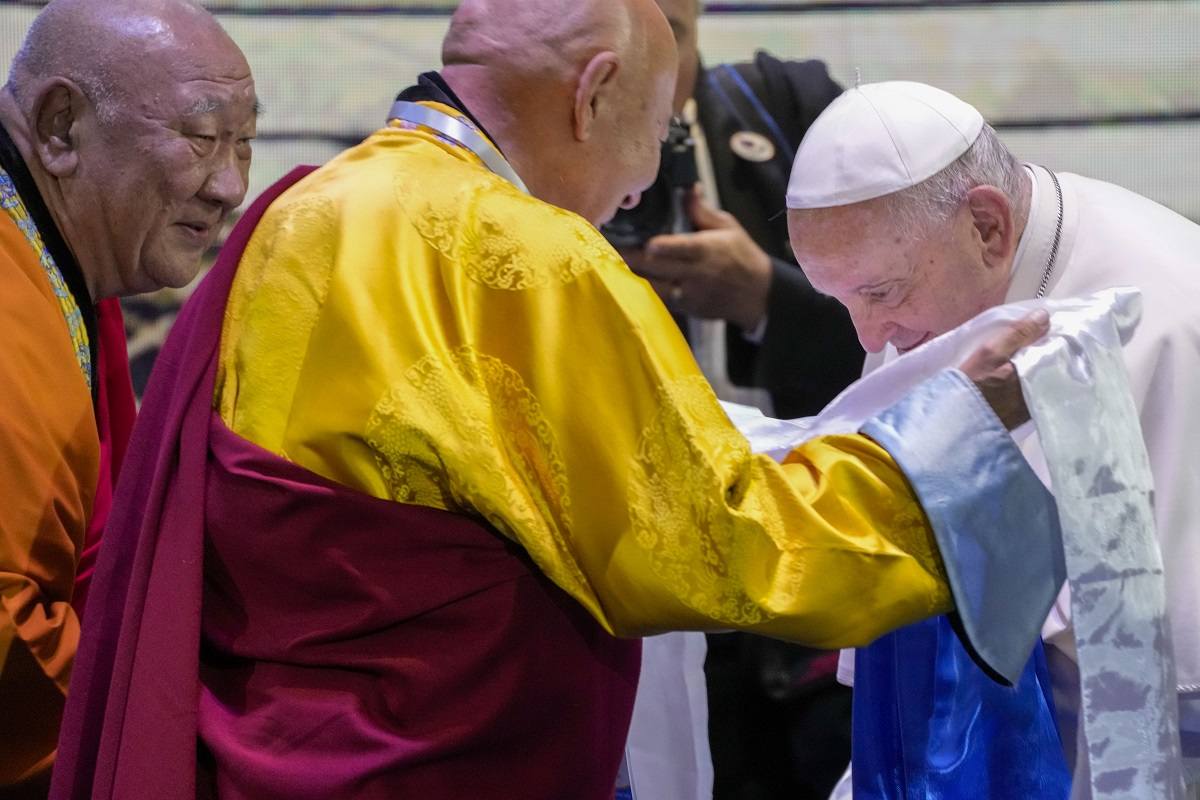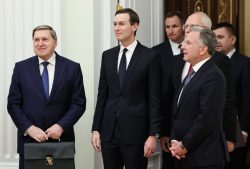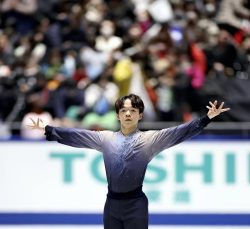Pope Joins Shamans, Monks and Evangelicals to Highlight Mongolia’s Faith Diversity, Harmony

Pope Francis, right, is welcomed by Choijiljav Dambajav, abbot of the Buddhists’ Zuun Khuree Dashichoiling Monastery in Ulaanbaatar and Gabju Demberel Choijamts, abbot of the Buddhists’ Gandantegchinlen Monastery in Ulaanbaatar, left, as he arrives at a meeting with religious leaders at the Hun Theatre in the Sky Resort compound some 15 kilometers south of the Mongolian capital Ulaanbaatar, Sunday, Sept. 3, 2023.
17:49 JST, September 3, 2023
ULAANBAATAR, Mongolia (AP) — With China’s crackdown on religious minorities as a backdrop, Pope Francis joined Mongolian shamans, Buddhist monks and a Russian Orthodox priest Sunday to highlight the role that religions can play in forging world peace, as he presided over an interfaith meeting highlighting Mongolia’s tradition of religious tolerance.
Francis listened intently as a dozen faith leaders — Jewish, Muslim, Bahai, Hindu, Shinto and evangelical Christian among them — described their beliefs and their relationship with heaven. Several said the traditional Mongolian ger, or round-shaped yurt, was a potent symbol of harmony with the divine — a warm place of family unity, open to the heavens, where strangers are welcome.
“The fact that we are meeting together in one place already sends a message: it shows that the religious traditions, for all their distinctiveness and diversity, have impressive potential for the benefit of society as a whole,” Francis said in remarks that cited Buddhist writings, his namesake St. Francis of Assisi and the existential philosopher Soren Kierkegaard.
“If the leaders of nations were to choose the path of encounter and dialogue with others, it would be a decisive contribution to ending the conflicts continuing to afflict so many of the world’s peoples,” he said.
The interfaith event, held at a theater in the capital, Ulaanbaatar, came midway through Francis’ four-day visit to Mongolia, the first by a pope. He is in Mongolia to minister to one of the world’s smallest and newest Catholic communities and highlight Mongolia’s tradition of tolerance in a region where the Holy See’s relations with neighboring China and Russia are often strained.
According to statistics by the Catholic nonprofit group Aid to the Church in Need, Mongolia is 53% Buddhist, 39% atheist, 3% Muslim, 3% Shaman and 2% Christian.
Later Sunday, Francis was to preside over a Mass in the capital’s sports stadium that the Vatican had said would also be attended by pilgrims from China. One small group of Chinese faithful from Xinjiang attended his meeting at the city’s cathedral Saturday. They held up a Chinese flag and chanted “All Chinese love you” as his car drove by.
“We have always been looking forward to it. We really hope that gradually our government and leaders will accept him and invite him to visit our country,” said Yan Zhiyong, a Chinese Catholic businessman in Mongolia who attended the event. “That would be the most joyful thing for us.”
The Vatican’s difficult relations with China and Beijing’s crackdown on religious minorities have been a constant backdrop to the trip, even as the Vatican hopes to focus attention instead on Mongolia and its 1,450 Catholics. No mainland Chinese bishops are believed to have been allowed to travel to Mongolia, whereas at least two dozen bishops from other countries across Asia have accompanied pilgrims for the events.
Hong Kong Cardinal-elect Stephen Chow, who made a historic visit to Beijing earlier this year, was on hand and accompanied 40 pilgrims to Mongolia, saying it was an event highlighting the reach of the universal church. He declined to discuss the absence of his mainland Chinese counterparts, focusing instead on Francis and the importance of his visit to Mongolia for the Asian church.
“I think the Asian church is also a growing church. Not as fast as Africa — Africa is growing fast — but the Asian church also has a very important role to play now in the universal church,” he told reporters.
Chinese President Xi Jinping has demanded that Catholicism and all other religions adhere strictly to party directives and undergo “Sinicization.” In the vast Xinjiang region, that has led to the demolition of an unknown number of mosques, but in most cases it has meant the removal of domes, minarets and exterior crosses from churches.
The Vatican and China did sign an accord in 2018 over the thorny issue of Catholic bishop nominations, but Beijing has violated it.
Most Mongolians follow the dominant Gelugpa school of Tibetan Buddhism and revere its leader, the Dalai Lama. As a result, many Mongolians are concerned with the Chinese Communist Party’s opposition to the exiled Tibetan leader and its heavy-handed control over monastic life and what appears to be a concerted effort to gradually eliminate Tibetan culture.
Yet, given the need to maintain stable relations with Beijing — China is Mongolia’s top export partner — the country’s leaders have not spoken out on the matter, just as they have remained largely silent about repressive linguistic and cultural policies toward their ethnic brethren in China’s Inner Mongolia region.
Francis also has largely avoided antagonizing Beijing, most significantly by avoiding any criticism of Beijing’s religious crackdown or by meeting with the Dalai Lama.
While the Dalai Lama wasn’t on hand Sunday, he was mentioned by the head of Mongolia’s main Tibetan Buddhist monastery, Khamba Nomun Khan Gabju Choijamts Demberel.
The abbot noted that “His Holiness,” as the Dalai Lama is known, had recently recognized the 10th reincarnation of the head lama of Mongolian Buddists known as the Jebtsundamba Khutughtu.
“This is an extraordinary fortune for us,” said the abbot, adding that the young lama was currently enaged in his studies of religion and other subjects.
The Dalai Lama’s recognition of the new lama has posed a problem, given that China has required all reincarnated lamas to be born within China and be officially certified by Beijing. The newly recognized Mongolian lama meets neither criteria.
In addition to China, Russia’s war in Ukraine also loomed large in the background of Sunday’s encounter.
The rector of the only Russian Orthodox Church in Ulaanbaatar, Father Antony Gusev, told the gathering the history of the church in Mongolia, recalling that the current head of the Russian church — Patriarch Kirill — laid the foundation stone for the building in 2001.
Kirill has strongly backed Russia’s war in Ukraine, straining relations with the Holy See that had made a breakthrough only a few years ago when Francis and Kirill met in Hanava in the first-ever meeting between a pope and Russian patriarch.
"News Services" POPULAR ARTICLE
-

American Playwright Jeremy O. Harris Arrested in Japan on Alleged Drug Smuggling
-

Japan’s Nikkei Stock Average as JGB Yields, Yen Rise on Rate-Hike Bets
-

Japan’s Nikkei Stock Average Licks Wounds after Selloff Sparked by BOJ Hike Bets (UPDATE 1)
-

Japan’s Nikkei Stock Average Buoyed by Stable Yen; SoftBank’s Slide Caps Gains (UPDATE 1)
-

Japanese Bond Yields Zoom, Stocks Slide as Rate Hike Looms
JN ACCESS RANKING
-

Keidanren Chairman Yoshinobu Tsutsui Visits Kashiwazaki-Kariwa Nuclear Power Plant; Inspects New Emergency Safety System
-

Imports of Rare Earths from China Facing Delays, May Be Caused by Deterioration of Japan-China Relations
-

University of Tokyo Professor Discusses Japanese Economic Security in Interview Ahead of Forum
-

Tokyo Economic Security Forum to Hold Inaugural Meeting Amid Tense Global Environment
-

Japan Pulls out of Vietnam Nuclear Project, Complicating Hanoi’s Power Plans
























